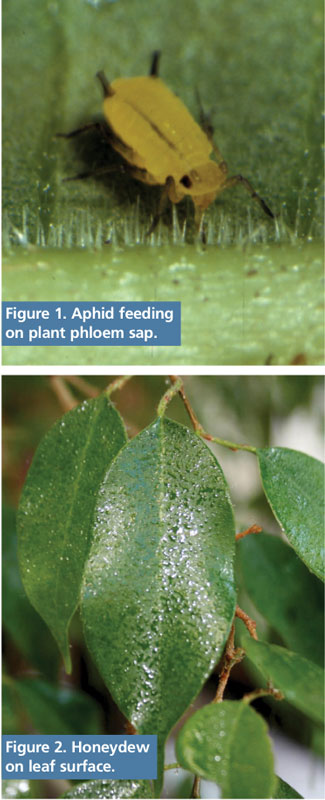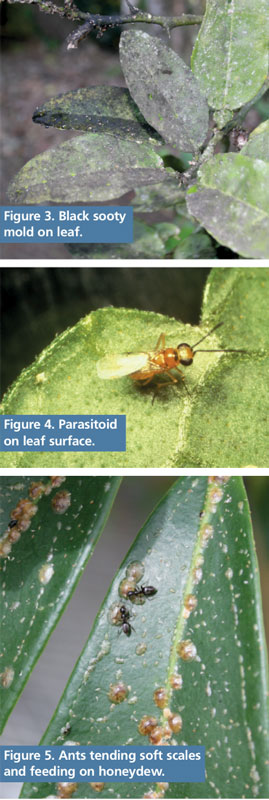6/1/2020
Honeydew: What Is It?
Dr. Raymond A. Cloyd

Sucking insects—such as aphids, leafhoppers, mealybugs, soft scales and whiteflies—feed on plant phloem sap (Figure 1), which transports nutrients, including photosynthates, within the plant. Plant phloem sap consists of carbohydrates (sugars) and nitrogen, and is the primary food source of sucking insects. Most sucking insects prefer feeding on the underside of leaves to minimize exposure to ultraviolet light and obtain easier access to the plant phloem sap. After digestion and assimilation, the ingested phloem sap is modified in composition for transport through the insect gut, and the residue or excess sugar is expelled or excreted out the anus as honeydew (Figure 2).
The presence of honeydew indicates that sucking insects are ingesting large volumes of phloem sap to obtain adequate quantities of less abundant nutrients, especially amino acids, which are present in small concentrations. These amino acids are required for growth and reproduction of sucking insect pests.
Honeydew is a complex mixture of chemical compounds, including carbohydrates (sugars) and amino acids. Honeydew is a sugar-rich excretion with the primary sugars being glucose and fructose. The sugar content of honeydew can vary depending on the sucking insect and plant fed upon.
Honeydew can be produced in copious amounts by most sucking insects. Many aphid species excrete large quantities of honeydew. For instance, first instar larvae of certain aphids can produce more honeydew per hour than their own body weight.
Honeydew also serves as a growth medium or substrate for black sooty mold (Figure 3), which can reduce the plant’s ability to manufacture food by means of photosynthesis. Furthermore, honeydew is an important food source for natural enemies (e.g., parasitoids and predators) and ants.
Natural enemies
Honeydew acts as a kairomone (volatile chemical emitted by one insect that’s detected by a different insect from a distance) for certain natural enemies, especially parasitoids, serving as a food source or helping parasitoids locate prey. For instance, many female aphid parasitoids feed on aphid honeydew as a carbohydrate (sugar) source and the presence of honeydew helps parasitoids locate aphids by decreasing the time spent searching the leaf surface area.
Aphid parasitoids are attracted to the honeydew produced by aphids, which can increase the searching efficiency of females. In addition, the odors or volatiles emitted from honeydew increases the ability of female parasitoids to locate aphids on plants. Contact with honeydew may also assist parasitoids in determining if prey are present. Moreover, contact with honeydew on leaves may affect the foraging behavior of natural enemies, which can influence the time spent on a leaf searching for prey, thus increasing the likelihood of finding prey (e.g., aphids). Female parasitoids will stop and touch honeydew with their antennae and mouthparts, which allows them to obtain cues regarding the presence of prey within an area.
 The whitefly parasitoid, Encarsia formosa, is not attracted to the odors from honeydew produced by the greenhouse whitefly, Trialeurodes vaporariorum. However, the parasitoid will search an area more after contacting honeydew. Contact with honeydew retains parasitoids within an area where prey are present, thus increasing the likelihood of encountering prey.
The whitefly parasitoid, Encarsia formosa, is not attracted to the odors from honeydew produced by the greenhouse whitefly, Trialeurodes vaporariorum. However, the parasitoid will search an area more after contacting honeydew. Contact with honeydew retains parasitoids within an area where prey are present, thus increasing the likelihood of encountering prey.
Honeydew is an important cue that helps searching parasitoids locate prey after landing on a plant (Figure 4). The presence of honeydew on the upper leaf surface indicates that aphids are feeding on leaf undersides, which assists parasitoids in locating aphids on plants. Furthermore, honeydew stimulates parasitoid searching and retention in areas where prey are present, and can also be used to recognize specific prey.
Honeydew can be degraded by ultra-violet light and washed-off plants by overhead irrigation, which could reduce parasitoid searching efficiency. However, the age of the honeydew may influence susceptibility to ultraviolet light degradation and wash-off from overhead irrigation. In addition, the age and concentration of honeydew residues on leaves can affect attraction to parasitoids. Fresh (one to three days old) honeydew may emit more volatiles than older (over seven days old) honeydew. Moreover, as honeydew ages and crystallizes (becomes less liquid) this reduces attraction to parasitoids. Consequently, the honeydew will not help parasitoids locate prey.
The behavior of certain predators is influenced by the presence of honeydew. For example, odors or volatiles emitted from aphid honeydew helps larva of the aphid predatory midge, Aphidoletes aphidimyza, locate aphids. In addition, females of the aphid predatory midge feed on honeydew to increase egg development. The adults of the green lacewing (Chrysopa spp.), which aren’t predaceous, feed on honeydew as a food source.
Ants
Ants rely on the honeydew excreted by sucking insects as a food source. In addition, ants will tend sucking insects (Figure 5) to obtain the food, as well as protect them from their natural enemies (e.g., parasitoids and predators). Therefore, greenhouse producers that plan to implement a biological control program against sucking insects must initially control ants. GT
Dr. Raymond A. Cloyd is a Professor and Extension Specialist in Horticultural Entomology/Plant Protection at Kansas State University in Manhattan, Kansas. He can be reached at rcloyd@ksu.edu or (785) 532-4750.